
In a mouse study, researchers have found a better way than natural healing to repair damaged insulation surrounding nerve cells.
Normally, the natural healing process of the insulation surrounding nerves adds bumps to the surface of the protective fatty sheath, known as myelin, each time it’s repaired, eventually causing the nerve to lose function.
In the case of Multiple Sclerosis (MS), the body’s immune system mistakenly attacks the myelin sheath around nerves, shutting it down and causing communication problems between the brain and the rest of the body. In the study, published in Science Advances, the Johns Hopkins Medicine researchers say that using certain drugs may prevent relapsing-remitting MS, the intermittent form of the disorder, from becoming progressive MS — a chronic form of the condition in which the myelin can no longer repair itself.
Multiple Sclerosis
In earlier work, a team, led by Norman Haughey, Ph.D., professor of neurology at the Johns Hopkins University School of Medicine, looked at the composition of the myelin surrounding nerves, founding near injured brain tissue taken from deceased people with MS. Myelin is made mostly from hundreds of types of fat molecules and proteins. The researchers saw that myelin around nerves near injury sites looked misshapen compared with that of other nerves, along with having much higher levels of ceramide — a particular type of fat molecule — and lower levels of another fat molecule called sulfatide.
Professor Haughey said: “Suppressing the immune system has worked to treat relapsing-remitting MS, but it doesn’t protect from the eventual advancement to progressive MS, for which there aren’t any good treatments on the market. We think these findings are a big step towards improving the quality and composition of myelin following a flare-up.”
The Johns Hopkins Medicine team highlight that having the correct amount of ceramide is especially important because this fat regulates the curvature of myelin, with too much ceramide creating “bumps” in the myelin.
Using animal models
In this new study, the researchers fed the drug cuprizone to mice for 26 days to damage the myelin on their nerve cells. The myelin repaired itself but looked bumpy and wrapped poorly around the nerve because of the excess ceramide. In a series of experiments, the researchers found that brain inflammation activates the enzyme, neutral sphingomyelinase-2, which produces ceramide.
Working with an expert drug development team led by Barbara Slusher, Ph.D., M.A.S., professor of neurology at the Johns Hopkins University School of Medicine, the researchers identified the small molecular size drug, cambinol, which blocks neutral sphingomyelinase-2 from working, theorising that this would prevent excess ceramide from being made and incorporated into regenerated myelin after an injury.
The researchers gave the mice the cuprizone for nearly a month and followed this by injecting cambinol, finding that the myelin sheath grew back, wrapping tightly around the neurons and looked like it did before the damage.
The researchers say this intervention did not completely restore the fat composition of myelin, however, it appeared to increase the stability of the myelin, which likely would better protect the underlying neurons. They will not determine if there are any impacts of other abnormal fat levels with the prevention of excess ceramide, and whether the myelin functions as it should and is stable over long periods of time.
The team hopes to develop small molecular-size inhibitors of neutral sphingomyelinase-2 for eventual use in human trials once they have carried out their further research.
Postdoctoral fellow Seung-Wan Yoo, Ph.D., M.S., is the lead author of this study.








This is exciting. I’m day 16. Guillan Barre. Any advances in myelin sheath self repair is needed.